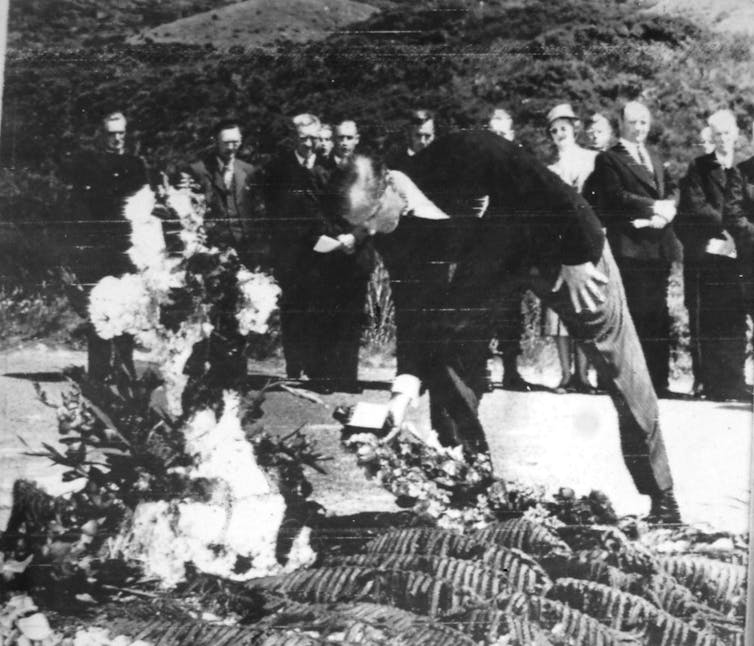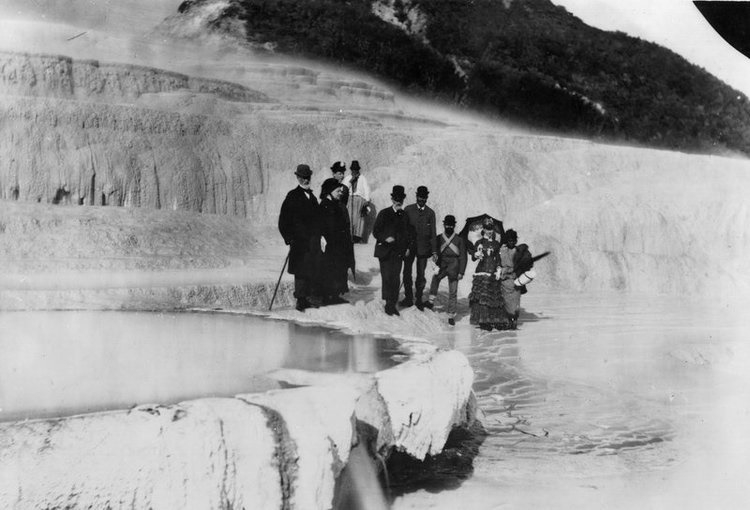Only minutes before midnight on Christmas Eve, 1953, the engine driver of the Wellington to Auckland express train will notch back to walking pace in a remote area of New Zealand's North Island's 'volcanic plateau. Most passengers will be sleeping.
The train consisting of eight carriages, a heating unit, postal and guard's van will approach the double span steel trestle bridge, lit by the headlight of the powerful throbbing DX locomotive. At a strategic point the driver will cast a floral tribute into the darkness, where it will come to rest in the gentle waters below to mark the tragic events that occurred here 70 years ago in 1953.

Chances are the train crew may shed a tear or two, ...and this is only fitting as the Maoris people call this place Tangiwai ...'weeping waters'.
For those who are fortunate to travel this route by day, the scenery is grand. Here on the Central Plateau , rise three volcanoes, Ruapehu, Ngauruhoe and Tongiriro. In the winter these mountains are clad in snow, as often is the railway line itself. These mountains form part of a chain that start out in the Bay of Plenty with another active volcano, Whites Island ...embraces Mt Edgecumbe and the historic Mt Tarawera that destroyed the famous Pink and Whites terraces in 1886 and takes in the Southern Alps with New Zealand's highest peak, Mt Cook, terminating at Milford Sound. Both Edgecumbe and Tarawera remain extinct, whilst the South Island has thermal activity , but no volcanoes .
Pink and White Terraces prior to their destruction in 1886 following the erutpion of Mount Tarawera,
To the east of Mt Ruapehu massive steel trusses straddle an 'insignificant stream'. This bridge looks absurd , out of all proportion to the mere trickle of water below it. Today's environmentalists may cry vandalism. Yet these cries pale against those that rent the air that fateful Christmas Eve in 1953.
There was laughter and joy on the express that night. Parents wrestled with their children trying to get them off to sleep. "Will Santa really come on the train tonight" they would ask innocently. As the vestibule door slammed with that familiar sound, followed by the guard walking down the aisle pointing his torch toward the floor, the lights would progressively go out The rhythm of the bogies passing over the rail joints, the ever present clickety- clack finally inducing sleep.
Out in front of the train the pride and as it turned out the zenith of of New Zealand Railways steam locomotives 'Ka'949, grappled with the inclines and checked on the descents . Occasionally from the window could be seen the long probing of light , dancing on the surrounding bush. The 'K's were honest toilers, built in the 1930's to tackle increasing workloads . The 4-8-4 'Mountain' locomotives were later converted to oil-burners and were identified by the class as 'Ka'. They gave off a distinctive aroma of smoke and diesel , that often wafted into the carriages behind. The sound of a 'Ka 'working on a full head of steam was akin to a well tuned orchestra. 'Ka' 949 only four months out of a major overhaul epitomised her class that night as she hauled five second class , four first class, a baggage and postal van through the mountain terrain. In a long sweeping bend to the right the train levelled out down the mile long descent to the open box section Tangiwai bridge. Not far ahead the world famous Raurimu Spiral , where the track completes a complicated loop, engages two tunnels and crosses above itself. 'Ka' 949 bristling at the head of the train is all business as she thunders toward the bridge at 50 mph.
In the distance the fireman sees a flickering light . Moments later George Ellis, frantically waving his five cell torch watches helplessly alongside the track as the monster speeds by followed by darkened carriages. To his horror he realises it is the Main Trunk Express.
Cyril Ellis, a Postal Clerk is travelling north with his wife and mother-in-law, heading for the small town of Rangataua. Approaching the road bridge he is amazed to see the rapidly rising yellow flood waters, flowing over it. Sensing immediate danger
he backs his old truck onto higher ground and gets out to investigate. Outside he is instantly aware of a muted roar. In the distance behind him he sees approaching headlights .
Horror grips him as he realises that the powerful light is that of an approaching train. Instinctively he clambers up the embankment onto the railway track. Running between the rails toward the train he frantically waves his torch.

Meanwhile some miles away Mount Ruapehu, having been quiet for months, stirs heating the ice filled crater lake. Scoria, ash and ice have formed a wall, damming the waters. The rising heat causes the wall to collapse releasing a mountainous torrent to descend into the river -bed. . It is estimated to be twenty feet high. Spewing forth in a seething mass of angry water, this juggernaut carries with it boulders and debris. Standing in its path two bridges; one rail, one road. Critically weakened the rail bridge remains intact, the road bridge is swept away.

What happened in the locomotive cab that night we will never know. Did the engine driver see the two gleaming rails ahead of him? The oil to the burner had been shut off, indicating that the fireman realised danger and acted.

George Ellis the Post Office employee, who was subsequently awarded the George Cross for bravery, watched the horror as the locomotive dived to the left taking with it five carriages, into the cauldron below. Along with the guard on the train Bill Inglis, (awarded the British Empire Medal) he raced to the bridge to find the sixth coach hovering on the brink. Between them they rescued 21 of the 22 occupants , before it too toppled into the waters below. Daylight revealed the magnitude of the disaster. 'Ka' 949 along with the sixth coach were strewn across the river-bed torn, twisted, tangled and twisted. One carriage was swept a mile and a half downstream , its bogies never recovered .
In the aftermath you could have waded across the stream without wetting you knees, yet such was the force and volume of the water at the time the ill fated train coincided with the lahar that sixty-five ton were swept away .
One hundred and fifty-three passengers , died that night. Twenty-eight were never recovered ..
This year many New Zealanders will pause in remembrance of those who perished that terrible night , 70 years ago, when Christmas never came.
As the DX's throttle is opened, bringing forth a deepening growl for the incline ahead , the crew of the Wellington-Auckland Express will remember their colleagues, driver Charles Parker and fireman Lance Redman, who rode the footplate of 'Ka' 949. Others across the nation will shed a tear or two, perhaps looking at a doll or train set, that was never given.
"Mummy, will Santa really come on the train tonight"?
-----------------------------------------------00000000000000----------------------------------
PS: Many years later after the new trestle bridge was built I visited the site. I stepped across the gentle trickling stream and never wet the soles of my shoes.
I recount this story that occurred so many years ago. Dec 24th 1953, with the same sadness as that when the nation woke up to the dreadful news that Christmas Day. Only seven years previous as a twelve year old I and my family were passengers on the same Auckland-Wellington Express, on Christmas Eve.
Footnote:
If there was a highpoint in New Zealand royalism, it was witnessed during the first visit by the young Queen and Duke of Edinburgh between December 23 1953 and January 30 1954.
Less than 40 hours after her arrival, the young Queen’s leadership was put to the test when over a 150 people died in the Tangiwai rail disaster on Christmas Eve. She visited survivors and included words of comfort in her speeches, cementing her connection to the grieving, and to the country.

The Duke of Edinburgh places a wreath at the mass funeral in Wellington for victims of the Christmas Eve rail disaster at Tangiwai. Getty Images
BLOG COMMENTS POWERED BY DISQUS

































































